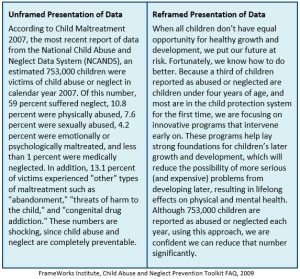Are Your Numbers Telling the Right Story?
August 9, 2018 Facts matter and data has become ubiquitous in editorials, brochures, social media posts, websites, and other products. We in the human service sector tend to use numbers as advocacy tools, to portray the needs of our constituencies and communities, and to share the scope of our programs. Unfortunately, these common uses of data often fail to accomplish their goal of educating and persuading the public for a number of reasons, including the following.
Facts matter and data has become ubiquitous in editorials, brochures, social media posts, websites, and other products. We in the human service sector tend to use numbers as advocacy tools, to portray the needs of our constituencies and communities, and to share the scope of our programs. Unfortunately, these common uses of data often fail to accomplish their goal of educating and persuading the public for a number of reasons, including the following.
- Numbers can’t stand alone. Presenting data without context allows the public to fill in their own story and default to common misconceptions, stereotypes, and cultural models, including Individualism and Fatalism. Additionally, if presented with unframed facts that don’t conform to or even challenge their existing worldview, people tend to dismiss the facts.
- Crisis doesn’t work. Using numbers to convey the enormity of a problem frequently results in telling the Crisis story, which FrameWorks Institute’s research shows paralyzes instead of motivates people. It reinforces that the problem is too big to tackle, that the government is too incompetent to fix it, and that there are no solutions.
- Showing only problems is problematic. Similarly, we considerably focus on the negative when sharing data rather than balancing it with the positive. Providing overwhelming, uninterpreted numbers about a problem blinds the audience to the causes or solutions. They evoke a model of naturalism where “that’s just the way it is” thereby ignoring issues of prevention, policy impacts, and government responsibility. Even when a small solution is suggested after presenting a big problem, the audience is still left feeling a sense of futility.
Effectively Reframing the Facts
The data itself cannot be the story, it must always be used as a proof point to support the message frame. Incorporating facts within a story also allows for better integration of the narrative elements – the values and metaphors – that are shown to successfully engage the public. As in the case with the Building Well-Being Narrative, order matters. It is important to first establish the frame, then to supply the fact that supports it. The audience will also be more receptive if you reduce the number of facts presented so as to not overwhelm them and to balance the problem with manageable solutions. Take this example from the FrameWorks Institute’s research on child abuse and neglect prevention.

The unframed example piles on statistics about the scope of the problem without offering context or a sense that there are solutions to address the challenge of child abuse and neglect. By contrast, the reframed example prioritizes explanation over raw data. The tone is pragmatic, the balance of the piece is focused on solutions, and it utilizes the construction metaphor and appeals to a universal benefit.
FrameWorks also recommends other communications devices to help the public see the truth behind the numbers and support policy and programmatic recommendations, including explanatory chains and social math.
- Explanatory Chains. Explanatory Chains, or causal stories, present an unbroken, linear explanation that logically connect causes to consequences and fill in gaps in the audience’s understanding. Explanatory Chains provide broader context, show how the problem is related to human decisions, and offer concrete solutions. They generally start a few steps back to give the big picture or background view, provide the necessary mediating factors, and end with the consequence. Causal stories are strengthened when kept concise and utilizing signposting terminology such as “consequently” or “as a result” to help the audience follow the flow.
This recent article by FrameWorks offers the following example that connects children’s housing and education as well as other helpful insights for using Explanatory Chains effectively. We also recommend the FrameWorks Institute FrameByte: Creating Causal Chains.

- Social Math. Social Math is an analogy-based communication and advocacy technique that combines stories and numbers by comparing the data point to something familiar. The key to Social Math should be “figuring out what part of the frame you want to bolster with greater vividness.” It can support the frame by comparing the size, connecting familiar or unfamiliar objects and issues, or making an abstract issue more concrete through a metaphor. However, Social Math can backfire if you use the wrong comparison. As a result, it is important to consider what reasoning your equation is setting up and make sure it leads in the intended direction. Here is one example from FrameWorks that creates a striking visual picture to make sense of an otherwise incomprehensible number.

Check out these additional resources from FrameWorks for tips and examples of effective social math: Doing Social Math: Case Study in Framing Food and Fitness and Budget and Taxes: Using Data Effectively.
SPOTLIGHT
The National Assembly has launched a podcast, What the Hill, to explore policy issues relevant to the human service sector. In the pilot episode, the policy team examine the Administration’s misguided proposal to reorganize the executive branch of the federal government, including a discussion with the Reframing Initiative’s Malore Dusenbery on the framing and narrative implications of the recommendations. Click here to listen and stay tuned for upcoming episodes!

